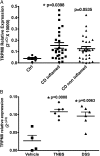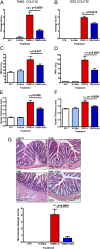TRPM8 activation attenuates inflammatory responses in mouse models of colitis
- PMID: 23596210
- PMCID: PMC3645521
- DOI: 10.1073/pnas.1217431110
TRPM8 activation attenuates inflammatory responses in mouse models of colitis
Abstract
Transient Receptor Potential Melastatin-8 (TRPM8), a recently identified member of the transient receptor potential (TRP) family of ion channels, is activated by mild cooling and by chemical compounds such as the supercooling agent, icilin. Since cooling, possibly involving TRPM8 stimulation, diminishes injury-induced peripheral inflammation, we hypothesized that TRPM8 activation may also attenuate systemic inflammation. We thus studied the involvement of TRPM8 in regulating colonic inflammation using two mouse models of chemically induced colitis. TRPM8 expression, localized immunohistochemically in transgenic TRPM8(GFP) mouse colon, was up-regulated in both human- and murine-inflamed colon samples, as measured by real-time PCR. Wild-type mice (but not TRPM8-nulls) treated systemically with the TRPM8 agonist, icilin showed an attenuation of chemically induced colitis, as reflected by a decrease in macroscopic and microscopic damage scores, bowel thickness, and myeloperoxidase activity compared with untreated animals. Furthermore, icilin treatment reduced the 2,4,6-trinitrobenzenesulfonic acid-induced increase in levels of inflammatory cytokines and chemokines in the colon. In comparison with wild-type mice, Dextran Sodium Sulfate (DSS)-treated TRPM8 knockout mice showed elevated colonic levels of the inflammatory neuropeptide calcitonin-gene-related peptide, although inflammatory indices were equivalent for both groups. Further, TRPM8 activation by icilin blocked capsaicin-triggered calcitonin-gene-related peptide release from colon tissue ex vivo and blocked capsaicin-triggered calcium signaling in Transient Receptor Potential Vaniloid-1 (TRPV1) and TRPM8 transfected HEK cells. Our data document an anti-inflammatory role for TRPM8 activation, in part due to an inhibiton of neuropeptide release, pointing to a novel therapeutic target for colitis and other inflammatory diseases.
Conflict of interest statement
The authors declare no conflict of interest.
Figures





References
-
- Nathan C. Points of control in inflammation. Nature. 2002;420(6917):846–852. - PubMed
-
- Nathan C, Ding A. Nonresolving inflammation. Cell. 2010;140(6):871–882. - PubMed
-
- Sartor RB. Mechanisms of disease: Pathogenesis of Crohn’s disease and ulcerative colitis. Nat Clin Pract Gastroenterol Hepatol. 2006;3(7):390–407. - PubMed
-
- Xavier RJ, Podolsky DK. Unravelling the pathogenesis of inflammatory bowel disease. Nature. 2007;448(7152):427–434. - PubMed
Publication types
MeSH terms
Substances
Grants and funding
LinkOut - more resources
Full Text Sources
Other Literature Sources
Molecular Biology Databases
Research Materials
Miscellaneous

